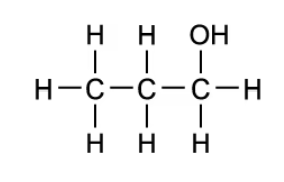Water has the ability to act as a solvent and dissolve many ionic and covalent compounds.
Which of the following 3-carbon compounds will not dissolve in water?
Propanoic acid

Propanol

Glycerol

Propane

Did this page help you?
Syllabus Edition
First teaching 2023
First exams 2025
Water has the ability to act as a solvent and dissolve many ionic and covalent compounds.
Which of the following 3-carbon compounds will not dissolve in water?
Propanoic acid

Propanol
Glycerol

Propane

Did this page help you?
The specific heat capacity of water is the highest of all liquids. Which of the following would be a correct definition of specific heat capacity?
The heat required to change one mole of liquid into one mole of gas.
The heat required to raise the temperature of 1kg of liquid by 1°C.
The heat required to change one mole of solid into one mole of liquid.
The ability of a solid to transfer heat to a liquid.
Did this page help you?
Which of the following are not examples of hydrogen bonding?
Base-pairing between two strands of DNA.
The forces that hold water molecules together.
The bond that joins one nucleotide to its neighbour in a strand of DNA.
Interactions between water and the polar R groups of certain amino acids.
Did this page help you?
Water (H2O) is a polar molecule, whereas methane (CH4) is nonpolar. Which of the properties of methane is explained by methane's lack of polarity?
Low molecular weight.
Low boiling point.
Flammability.
Greenhouse gas effect.
Did this page help you?
Which of the following observations is not explained by water's high latent heat of vaporisation and specific heat capacity?
Ice is less dense than liquid water, so it floats on water.
Water exists in all three physical states (solid, liquid and gas) on Earth.
A small volume of water can dissipate a lot of heat from an organism.
A lot of heat energy is required to raise the temperature of water.
Did this page help you?
Which row of the table lists the four common metabolites in decreasing order of solubility in water?
oxygen → sodium chloride → cholesterol → hydrophobic amino acid
sodium chloride → oxygen→ hydrophobic amino acid → cholesterol
hydrophobic amino acid → oxygen → sodium chloride → cholesterol
sodium chloride → hydrophobic amino acid → oxygen → cholesterol
Did this page help you?
Which of the following properties of water are a result of intermolecular forces?
I and II
I, II and III
I, II and IV
All
Did this page help you?
Which of the following properties of water stops enzymes from being denatured during transpiration?
I only
I and II
II, III and IV
III only
Did this page help you?
Sodium hydrogencarbonate (NaHCO3) dissociates into sodium ions (Na+) and bicarbonate ions (HCO3-) when it is dissolved. The latter creates an alkaline environment suitable for certain enzymes and bicarbonate ions in the blood help to buffer lactic acid during exercise.
How does water help the production of bicarbonate ions?
The oxygen atoms form ionic bonds with bicarbonate ions.
The oxygen atoms in water attract bicarbonate ions.
The hydrogen atoms form hydrogen bonds with bicarbonate ions.
The hydrogen atoms in water attract bicarbonate ions.
Did this page help you?
Water (H2O) and methane (CH4) are simple compounds with covalent bonds and a similar molecular mass.
In theory, this should mean that they share similar physical and chemical properties however, this is not the case.
The table below compares some of the features of methane and water:
| Water | Methane | |
| Molecular weight | 18 | 16 |
| Latent heat of vaporisation / kJ kg-1 | 2 260 | 510 |
| Specific heat capacity / kJ kg-1 °C-1 | 4.2 | 2.2 |
| Melting point / °C | 0 | -182 |
| Boiling point / °C | 100 | -162 |
Which of the statements below correctly describes the reason for these property differences?
Water is able to form hydrogen bonds with adjacent water molecules.
Methane forms a tetrahedral structure due to the fact carbon is able to form four covalent bonds.
Methane has a higher energy content in its bonds than water.
Water has a higher density than methane in a liquid state.
Did this page help you?
Which of the following does not rely on the specific heat capacity of water?
Heat loss through evaporation of sweat
Enzyme function
Aquatic ecosystems withstanding extreme temperature change
Humans living in sub-zero temperatures
Did this page help you?